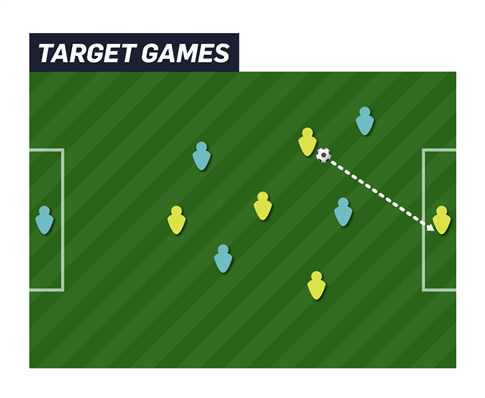In this blog, Bex Garlick, national coach development lead for women & girls, discusses the benefits of target games and how they can be adapted.
As has been highlighted over recent years, there are many benefits of using game-related practices. Not only do they help meet ‘game’ requests, from our young players, they also provide several opportunities to develop tactical understanding and decision making - realistic to the challenge of match day.
Target games are no exception to this as they offer a wide range of options and adaptations that can help meet learning objectives, for either the whole team or specific individuals. More specifically, target games can be useful for enhancing the holistic development of players as well as helping coaches manage differences within their sessions.
The example below demonstrates the common setup for a ‘target game’ with some simple rules and a scoring system.
 |
5v5To score a point, pass the ball to your teammate in the target box. Whoever plays the ball into the box switches with the target player. Can the opposition restart the game quickly whilst their opponents make the switch? |
In the next section, I discuss how these games aid technical and tactical development and how they help manage individual or team differences. I have then included various challenges and adaptations to highlight how this template might be developed over a few weeks to achieve different learning outcomes.
Technical and Tactical Development
Target games tend to lend themselves to the principles and technical components of attacking, with the scoring systems usually encouraging players to pass into a target box or zone or to a player. Not only can this assist with developing the receiving skills of the target player(s), who move to provide a supporting angle to receive the ball, it also challenges their teammates both off the ball and on the ball.
Firstly, teammates off the ball disperse to create space between the defensive lines, enabling penetration to occur. Secondly, the player with the ball must pass accurately and perhaps with some creativity as they look to penetrate the defence and play to the receiver. However, as with all game-related practices, the outcomes will also be dependent on the design, scoring system, and challenges that the coach has outlined within their session plan. Examples of which can be seen in the 'position specific’ table below.
Positions Specific Changes
| Midfielder | Forward | Defenders (Opposition) |
|---|---|---|
| Show me as many different movements you can make to support the forward. | What different ways can you combine with your teammate (s) to create goal-scoring opportunities? + Try to use one-touch where possible. |
Think about what tactics you might deploy to defend the target(s) |
| Consider the right time to pass to the forward, when you might play to space or when you might travel into the zone with the ball. | If you can, receive with your back to goal and score = 3 goals. | Try to reduce the time and space your opponent has to receive the ball. |
| You must play the ball between two defenders. | Move to give yourself more time and space when receiving the ball | If you win the ball back and play to one of your wide players in the target box, within less than 5 seconds, you score 3 points. |
Managing Difference
The ‘STEP’ principle is a useful tool in adapting practice to meet the specific needs of individuals, units or teams. During the planning process, it is important to take these needs into consideration as you create the relevant game conditions to challenge accordingly. For example, changing the space available within the target area can help individuals to recognise and utilise space more effectively. It can also help them to develop their technique when receiving the ball in tight areas.
Different tasks might also provide an opportunity to develop decision-making and awareness or allow for repetition of a technical component, such as passing.
Target games can be particularly useful when challenging players to play against someone with similar or differing technical or physical capabilities. To stretch individuals further, overloads and underloads (e.g. 7v3 or 6v4) can also be used.
Finally, equipment such as goals can be added to help with the scoring system and make games more similar to a matchday.
Further examples and their benefits are outlined in the ‘STEP’ table.
| Space | Task |
|---|---|
|
Reduce size
Increase size
Different Shape
|
Add more target zones
Scoring systems
Multi-directional or directional
|
| Equipment | Players |
|
Add goals
|
Add in a defender to ‘mark’ the target player
Add in more attackers/defenders to the target area to match up or create overloads Benefits:
|
It is important to consider the motivations and developmental wants and needs of your players and target games are a useful tool to help coaches/you achieve this.
What do you think of Bex’s ideas here? Do you use target games with your players? If so, how do you use and adapt them? Let us know below!


